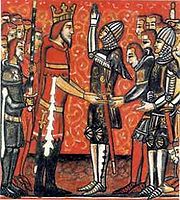
Fealty
Encyclopedia

Oath
An oath is either a statement of fact or a promise calling upon something or someone that the oath maker considers sacred, usually God, as a witness to the binding nature of the promise or the truth of the statement of fact. To swear is to take an oath, to make a solemn vow...
of fealty, from the Latin
Latin
Latin is an Italic language originally spoken in Latium and Ancient Rome. It, along with most European languages, is a descendant of the ancient Proto-Indo-European language. Although it is considered a dead language, a number of scholars and members of the Christian clergy speak it fluently, and...
fidelitas (faithfulness), is a pledge of allegiance
Allegiance
An allegiance is a duty of fidelity said to be owed by a subject or a citizen to his/her state or sovereign.-Etymology:From Middle English ligeaunce . The al- prefix was probably added through confusion with another legal term, allegeance, an "allegation"...
of one person to another. Typically the oath
Oath
An oath is either a statement of fact or a promise calling upon something or someone that the oath maker considers sacred, usually God, as a witness to the binding nature of the promise or the truth of the statement of fact. To swear is to take an oath, to make a solemn vow...
is made upon a religious object such as a Bible
Bible
The Bible refers to any one of the collections of the primary religious texts of Judaism and Christianity. There is no common version of the Bible, as the individual books , their contents and their order vary among denominations...
or saint's
Saint
A saint is a holy person. In various religions, saints are people who are believed to have exceptional holiness.In Christian usage, "saint" refers to any believer who is "in Christ", and in whom Christ dwells, whether in heaven or in earth...
relic
Relic
In religion, a relic is a part of the body of a saint or a venerated person, or else another type of ancient religious object, carefully preserved for purposes of veneration or as a tangible memorial...
, often contained within an altar
Altar
An altar is any structure upon which offerings such as sacrifices are made for religious purposes. Altars are usually found at shrines, and they can be located in temples, churches and other places of worship...
, thus binding the oath-taker before God.
In medieval Europe
Middle Ages
The Middle Ages is a periodization of European history from the 5th century to the 15th century. The Middle Ages follows the fall of the Western Roman Empire in 476 and precedes the Early Modern Era. It is the middle period of a three-period division of Western history: Classic, Medieval and Modern...
, fealty was sworn between two people, the obliged person (vassal
Vassal
A vassal or feudatory is a person who has entered into a mutual obligation to a lord or monarch in the context of the feudal system in medieval Europe. The obligations often included military support and mutual protection, in exchange for certain privileges, usually including the grant of land held...
) and a person of rank (lord
Lord
Lord is a title with various meanings. It can denote a prince or a feudal superior . The title today is mostly used in connection with the peerage of the United Kingdom or its predecessor countries, although some users of the title do not themselves hold peerages, and use it 'by courtesy'...
). This was done as part of a formal commendation ceremony
Commendation ceremony
A commendation ceremony is a formal ceremony that evolved during the Early Medieval period to create a bond between a lord and his fighting man, called his vassal . The first recorded ceremony of commendatio was in 7th century France, but the relationship of vassalage was older, and predated even...
to create a feudal relationship.
Fealty and homage
Homage (medieval)
Homage in the Middle Ages was the ceremony in which a feudal tenant or vassal pledged reverence and submission to his feudal lord, receiving in exchange the symbolic title to his new position . It was a symbolic acknowledgment to the lord that the vassal was, literally, his man . The oath known as...
are a key element of feudalism
Feudalism
Feudalism was a set of legal and military customs in medieval Europe that flourished between the 9th and 15th centuries, which, broadly defined, was a system for ordering society around relationships derived from the holding of land in exchange for service or labour.Although derived from the...
.
The term is also used by English-speakers to refer to similar oaths of allegiance in other feudal cultures, as with medieval Japan, as well as in modern political contexts.

